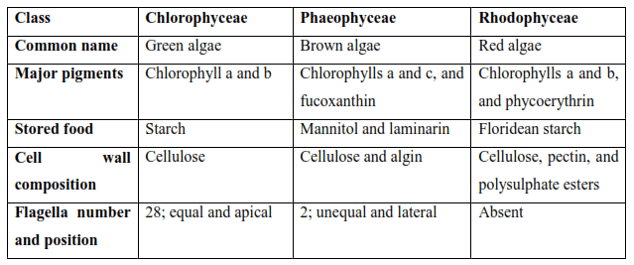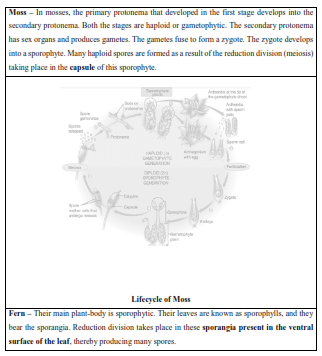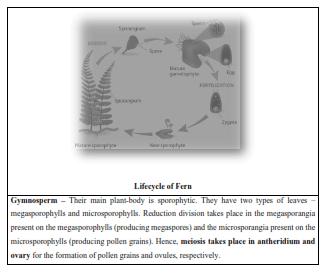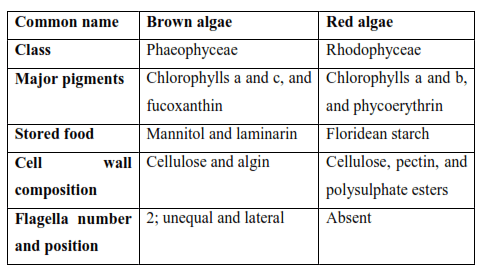
NCERT Solutions for Class 11 Biology chapter 3 Plant Kingdom PDF
Hey, are you a class 11 student and looking for ways to download NCERT Solutions for Class 11 Biology chapter 3 Plant Kingdom PDF? If yes. Then read this post till the end.In this article, we have listed NCERT Solutions for Class 11 Biology chapter 3 Plant Kingdom in PDF that are prepared by Kota’s top Doctor’s Faculties by keeping Simplicity in mind.
If you want to learn and understand class 11 Biology chapter 3 "Plant Kingdom" in an easy way then you can use these solutions PDF.
NCERT Solutions helps students to Practice important concepts of subjects easily. Class 11 Biology solutions provide detailed explanations of all the NCERT questions that students can use to clear their doubts instantly.
If you want to score high in your class 11 Biology Exam then it is very important for you to have a good knowledge of all the important topics, so to learn and practice those topics you can use eSaral NCERT Solutions.
In this article, we have listed NCERT Solutions for Class 11 Biology chapter 3 Plant Kingdom PDF that you can download to start your preparations anytime.
So, without wasting more time Let’s start.
Download NCERT Solutions for Class 11 Biology chapter 3 Plant Kingdom PDF
Question 1. What is the basis of classification of algae?
Solution: Algae are classified into three main classes - Chlorophyceae, Phaeophyceae, and
Rhodophyceae based on the following factors:
(a) Major photosynthetic pigment present
(b) Cell wall composition
(c) Form of stored food
(d) Number of flagella and position of the insertion

Question 2. When and where does reduction division take place in the life cycle of a liverwort, a moss, a fern, a gymnosperm and an angiosperm?
Solution:





Question 3. Name three groups of plants that bear archegonia. Briefly describe the life cycle of any one of them.
Solution: Archegonium are the female sex organs which produce the female gametes or eggs. They are present in the life cycles of bryophytes, pteridophytes, and gymnosperms.
The life cycle of a fern (Dryopteris)
- Dryopteris are common ferns with pinnate-compound leaves.
- Their main plant-body is sporophytic.
-The sporangia are borne on the ventral surfaces of mature leaves.
- Each sporangium has spore mother cells, and they undergo meiosis to produce haploid spores.
- Upon maturation, these spores dehisce and germinate to give rise to a heart-shaped gametophyte called prothallus.
- The prothallus has both male and female sex organs called antheridia and archegonia, respectively.
- The antheridia produce sperms which swim in the water to reach to the archegonia. The archegonia produce the egg.
- A zygote is formed as a result of fertilisation. The zygote matures into an embryo which in turn develops into a new sporophyte. The young plant comes out of the archegonium of the parent gametophyte.

Question 4. Mention the ploidy of the following: protonemal cell of a moss; primary endosperm nucleus in dicot, leaf cell of a moss; prothallus cell of a fern; gemma cell in Marchantia; meristem cell of monocot, ovum of a liverwort, and zygote of a fern.
Solution. - protonema cell of a moss: Haploid
- primary endosperm nucleus in dicot: Triploid
- leaf cell of a moss: Haploid
- prothallus cell of a fern: Haploid
- gemma cell in Marchantia: Haploid
- meristem cell of monocot: Diploid
- ovum of a liverwort: Haploid
- zygote of a fern: Diploid
Question 5. Write a note on economic importance of algae and gymnosperms.
Solution: Economic importance of Algae:
a. Agar is obtained commercially from Gelidium and Gracilaria, which is widely used in the preparation of jellies, puddings, cream, etc. Also, agarose, which is obtained from agar, is widely used in biotechnology labs for making gels to run DNA samples.
b. Carrageenin is used as an emulsifier in chocolates, paints, and toothpaste. It is obtained from the red algae.
c. Some of the marine algae such as Porphyra, Sargassum, and Laminaria are edible. Chlorella and Spirulina are rich in proteins. Hence, they are used as food supplements.
d. Antibiotic chlorellin is extracted out from Chlorella. Red algae - Corallina is used in treating worm infections.
Economic importance of Gymnosperm:
a. Conifers provide an enormous amount of softwood for construction, plywood, paper industry etc.
b. Seeds of Pinus (Chilgoza) are edible.
c. Ephedrine drug is obtained from Ephredra used in asthma and bronchitis. An anticancer drug Taxol is obtained from Taxus.
d. Resins are used commercially for manufacturing sealing waxes and water-proof paints. A type of resin known as turpentine is obtained from various species of Pinus. Sawdust of conifers is used in making linoleum and plastics.
Question 6. Both gymnosperms and angiosperms bear seeds, then why are they classified separately?
Solution: - The seeds of the gymnosperm are naked, whereas a membrane covers the seeds of the angiosperm. Hence, both gymnosperms and angiosperms are classified separately.
A. The other difference between angiosperms and gymnosperms is that the diversity of angiosperm is greater than the gymnosperm. The higher diversity indicated the angiosperms are adaptive to terrestrial ecosystems.
Question 7. What is heterospory? Briefly comment on its significance. Give two examples.
Solution: - Heterospory is the presence of two kinds of spores on the same plant.
- These spores differ in size. The smaller one is known as microspore (germinates to form the male gametophyte-pollen grain), and the larger one is known as megaspore (germinates to form the female gametophyte-egg). The male gametophyte releases the pollens, and these reach the female gametophyte to fuse with the egg. Inside the female gametophyte, fertilisation results in the development of the zygote.
- This retention and germination of the megaspore within the megasporangium ensure proper development of the zygote into a young embryo. The evolution of the seed habit is related to the retention of the megaspore. Heterospory is thus considered an important step in evolution as it is a precursor to the seed habit. The heterospory is the first step of evolution of seed development in gymnosperms and angiosperms.
- Heterospory evolved first in pteridophytes such as Selaginella and Salvinia.
Question 8. Explain briefly the following terms with suitable examples:-
(i) protonema,
(ii) antheridium,
(iii) archegonium,
(iv) diplontic,
(v) sporophyll,
(vi) isogamy
Solution (i) Protonema: The predominant-first stage of the life cycle of a moss is the protonema stage, which develops directly from a spore. It is a creeping, green, branched and frequently filamentous stage. Example: Sphagnum.
(ii) Antheridium: It is the male sex organ of bryophytes and pteridophytes, which is surrounded by a jacket of sterile cells. They produce biflagellate antherozoids.
Example: Selaginella.
(iii) Archegonium: It is the female sex organ of bryophytes, pteridophytes, and gymnosperms. They produce biflagellate antherozoids.
Example: Cycas.
(iv) Diplontic: It represents the gametophytic phase during the lifecycle of angiosperm and gymnosperm (seed-bearing plants). In this, the diploid sporophyte is dominant. If the gametophytic phase is represented by the single to the few-celled haploid gametophyte, such kind of lifecycle is termed as diplontic.
Example: Pinus.
(v) Sporophyll: The main plant body of the pteridophytes is sporophytic. The sporophytes bear sporangia that are subtended by leaf-like appendages called sporophylls.
Example: Nephrolepis.
(vi) Isogamy: It is a mode of reproduction in which there is a union or fusion of gametes of the same size and structure.
Example: Spirogyra.
Question 9. Differentiate between the following:-
(i) red algae and brown algae
(ii) liverworts and moss
(iii) homosporous and heterosporous pteridophyte
(iv) syngamy and triple fusion
Solution: (i) red algae and brown algae

(ii) liverworts and moss

(iii) homosporous and heterosporous pteridophyte


(iv) syngamy and triple fusion

Question 10. How would you distinguish monocots from dicots?
Solution.


Question 11. Match the following (column I with column II)

Solution.

Question 12. Describe the important characteristics of gymnosperms.
Solution. - The term gymnosperm is a Greek word (gymnos - naked, sperma - seeds), i.e., the seeds of these plants are naked - not enclosed in fruits. Their ovules are not enclosed by any ovary wall and remain exposed, both before and after fertilisation.
- They consist of tap roots. The roots of Pinus show symbiotec association with mycorrhiza, roots of Cycas are specialized roots called coralloid roots and are associated with $\mathrm{N}_{2}$ fixing cyanobacteria.
-The stems are branched (Pinus, Cedrus) or unbranched (Cycas). The body of gymnosperm ranges from medium to tall trees and shrubs. The redwood tree Sequoia is one of the tallest trees in the world.
-The leaves can be compound (pinnate in Cycas) or simple (in Pinus). Their leaves are needle-like, have a thick cuticle and sunken stomata - these help in preventing water loss.
- Gymnosperms are heterosporous as they bear two kinds of spores – microspores and megaspores.
- The flowers are absent in gymnosperms. The microsporophylls and megasporophylls are arranged to form compact male and female cones.
- Mostly pollination occurs through wind and pollen grains reach the pollen chamber of the ovule through the micropyle.
- The female and male gametophytes are dependent on the sporophyte. The seeds contain haploid endosperms and remain uncovered.
Also Read,
Download Class 11 Chemistry Notes free PDF.
Download Class 11 Biology Book Chapterwise free PDF.
Download Class 11 Biology Exemplar Chapterwise free PDF.
If you have any Confusion related to NCERT Solutions for Class 11 Biology chapter 3 Plant Kingdom PDF then feel free to ask in the comments section down below.
To watch Free Learning Videos on Class 11 Biology by Kota’s top Doctor’s Faculties Install the eSaral App
